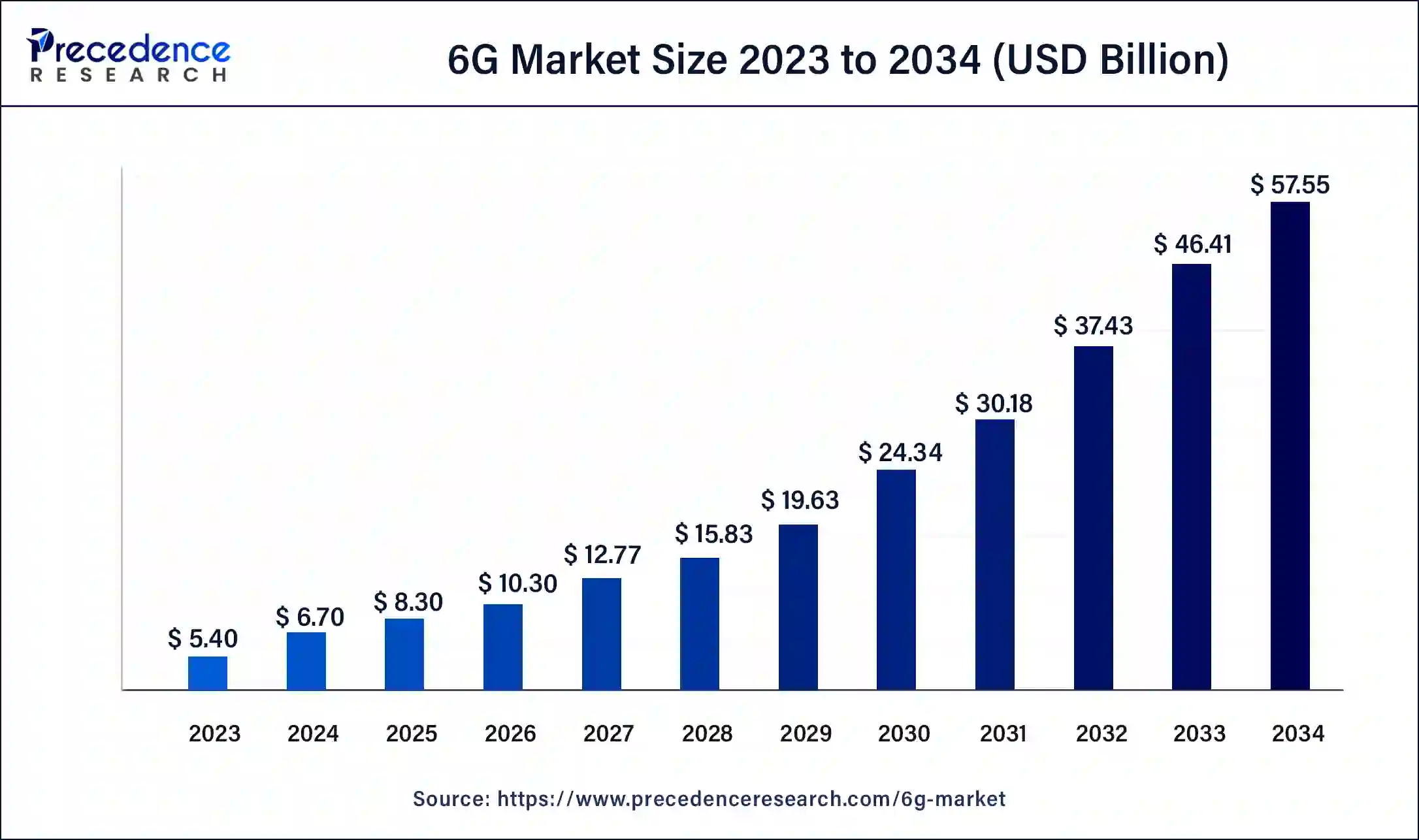The global 6G market size reached USD 5.40 billion in 2023 and is anticipated to grow around USD 46.20 billion by 2033, expanding at a CAGR of 23.94% from 2024 to 2033.
6G Market Key Takeaways
- The North America 6G market size reached USD 1.73 billion in 2023 and is expected to hit around USD 14.77 billion by 2033
- North America holds the largest share of 39% in the global 6G market in 2023.
- Asia Pacific is the fastest-growing region in the global market.
- By Infrastructure, wireless segment has accounted 80% revenue share in 2023.
- By vertical, the manufacturing segment held the largest share of the market.
- By application, the multisensory extended segment dominated the market in 2023.
- By deployment devices, the smartphone segment dominates the market globally.

The 6G market represents the next generation of wireless communication technology, expected to succeed 5G networks. As a transformative technology, 6G aims to provide ultra-fast data speeds, low latency, enhanced connectivity, and advanced capabilities such as holographic communication, immersive reality, and seamless integration with artificial intelligence (AI). Although the technology is still in the early stages of development, it holds the potential to revolutionize multiple industries, including telecommunications, healthcare, automotive, and entertainment.
Get a Sample: https://www.precedenceresearch.com/sample/4111
Growth Factors:
Several factors are expected to drive the growth of the 6G market. These include the increasing demand for faster and more reliable connectivity, the rise of the Internet of Things (IoT) and smart devices, and the need for improved network infrastructure to support emerging technologies such as AI and machine learning. Additionally, the expansion of smart cities and autonomous vehicles will necessitate the development of advanced communication networks, further propelling the adoption of 6G technology.
Region Insights: The 6G market is expected to see significant growth across various regions, with North America, Europe, and Asia-Pacific likely to lead the way. These regions have established technological ecosystems and strong investments in research and development, making them prime areas for 6G innovation. Additionally, these regions are home to major telecommunications companies and industry players actively working on 6G technologies.
Drivers: Key drivers for the 6G market include the need for ultra-high-speed connectivity to support data-intensive applications, the growing adoption of IoT devices, and the demand for improved network capacity and coverage. Moreover, advancements in AI and machine learning technologies are driving the need for more sophisticated communication networks to facilitate seamless integration.
Opportunities: The 6G market presents numerous opportunities for innovation and growth. These include the development of new applications and services enabled by ultra-fast data speeds and low latency, such as immersive virtual and augmented reality experiences. Additionally, there is potential for collaboration between telecommunications companies and other industries, such as healthcare and transportation, to create new use cases and business models.
Challenges: Despite its potential, the 6G market also faces challenges, including the high cost of research and development, regulatory hurdles, and the need for significant infrastructure upgrades. The complex nature of 6G technology may also require new standards and protocols, which could take time to establish. Additionally, concerns around data privacy and security may pose challenges as the technology becomes more widely adopted.
6G Market Recent Developments
- In February 2024, the U.S., Australia, Canada, the Czech Republic, Finland, France, Japan, South Korea, Sweden, and the UK released a joint statement stating that they support a set of shared principles for 6G for open, free, global, interoperable, reliable, resilient, and secure connectivity.
- In 2023, Nagoya University from Japan reported the successful fabrication of three-dimensional waveguides with niobium metal, which is basically a highly superconductive material that minimizes attenuation due to absorption and radiation, for transmission of waves in the 100GHz frequency band, deemed useful in 6G networking.
- In January 2022, Purple Mountain Laboratories of China claimed that its research team had achieved a world record of 206.25 gigabits per second (Gbit/s) data rate for the first time in a lab environment within the terahertz frequency band, which is supposed to be the base of 6G cellular technology.
6G Market Companies
- Huawei Technologies Co., Ltd.
- Nokia Corporation
- Samsung Electronics Co., Ltd.
- Ericsson
- Qualcomm Incorporated
- Intel Corporation
- Cisco Systems, Inc.
- Apple Inc.
- ZTE Corporation
- Mitsubishi Electric Corporation
Segments Covered in the Report
By Vertical
- Agriculture
- Educational and Entertainment
- Manufacturing
- Public Safety
By Application
- Multisensory Extended Reality
- Blockchain
- Autonomous and Robotic Systems
- Distributed Sensing and Communication
- Others
By Deployment Device
- Smartphones
- Tablets
- Wearables
- Internet of Things
- Others
By Communication Infrastructure
- Wireless
- Mobile Cellular
- Mobile Broadband
- Fixed
By Component
- Hardware
- Software
- Services
By Geography
- North America
- Europe
- Asia-Pacific
- Latin America
- Middle East and Africa
Contact Us:
Mr. Alex
Sales Manager
Call: +1 9197 992 333
Email: sales@precedenceresearch.com
Web: https://www.precedenceresearch.com
Blog: https://www.expresswebwire.com/
Blog: https://www.uswebwire.com/


0 Comments